#shimosuwa
Text
Ryokan: the Culture experience
As thrilled as I might have been to lounge around the Ryokan and Onsen the entirety of the long weekend, we decided it was for the best to actually go out and explore the area of Shimo-Suwa. It seemed the rural mountain town had a lot to offer in terms of cultural experiences, and who were we to deny ourselves of that?
Armed with a map sporting a "99 Minute Walking Tour of Shimo-Suwa," we ventured out of the Ryokan. I actually found the exact map we used, so feel free to check it out below:
We were on our way! Our first stop was to the side of the Raiko-Ji Buddhist temple, where we followed along the side of a large and beautiful cemetery until we happened upon what seemed to be a very old stone Torii gate. We bowed and entered, finding many shrines that were built in Japan's Edo period along the steep pathway and surrounded by a babbling stream. One of the most surprising shrines was a bright red Torii gate with a shrine that held many tiny statues of cats. This gate had clearly just been repainted, as it was very stark against the old stones that surrounded it.

It was not a great sign that all of us had already begun to feel the steep slopes in our leg muscles, yet we persevered and moved on to the next location. The Nasendo Highway is the path we had chosen to follow, which was high above the town below and provided beautiful views of the mountains and the whole valley. We passed by many beautiful traditional-style houses, and each seemed to have its own shrines set up meticulously in its backyard.
After a bit of walking, we made it to the gates of the Jiun-Ji Temple. It genuinely looked as though passing through the gate was entering another world, as everything was so dreary but through the gates the lush green moss was stark.
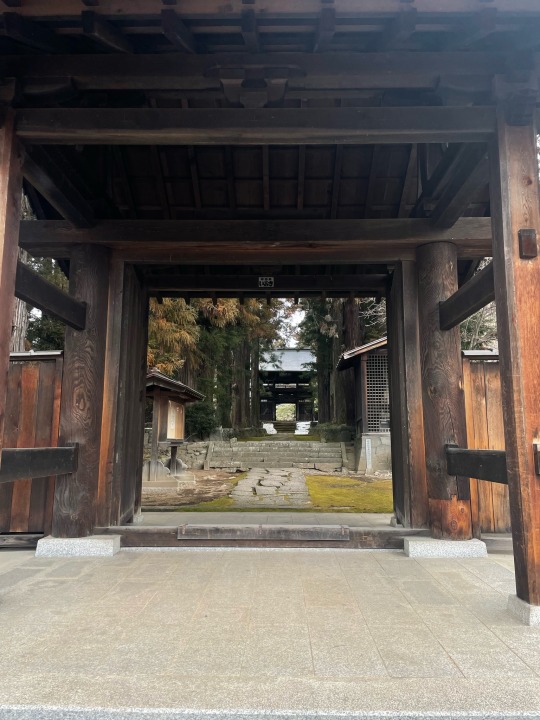
Inside, we walked carefully along the stone pathway to view the massive trees that lined the walkway. Inside, the Shrine was actively in use, as we could hear a priest chanting some kind of hymn from inside the main large shrine building. We had to strictly follow the pathway here, as all around us the loose pebbles were carefully arranged into a massive zen garden surrounding each building.

The path led us to a cemetery behind the shrine, where wooden buckets and ladles were located so that if/when a family or friend was visiting, they could cleanse the stones of their loved ones. Sound traveled quite well within the shrine, so we spoke in whispers and stepped very delicately, not wanting to disturb the priest. Down a steep stone staircase from the shrine was the Dragon's spout, where hot spring water always sprayed from a stone dragon's mouth that was carved in the middle Edo period. Though, honestly, it was more of a spittle than a spray of water.
Next, we made our way to the Harumiya Shrine. This shrine was very large and immaculately decorated, though honestly I was most compelled by the massive trees that stood around the shrine and were wrapped in some sort of special rope. I was told by Ash this was done by the priests to keep some form of spirit trapped within the trees they were wrapped on. By the entrance, two elderly attendants were stoking a fire. I'm not entirely sure why they did this, but it did add to the spiritual ambiance.
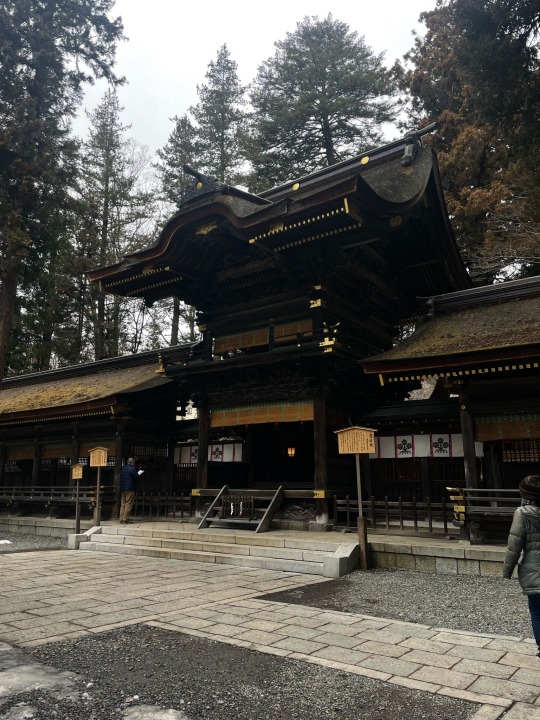
After exploring Harumiya for a while, we jaunted on over to the Ukashima-sha Shrine, which was very cool as it was located in the middle of a sandbar! Two bright red bridges metal connected the sandbar to the main mainland, which was really fun to run along.
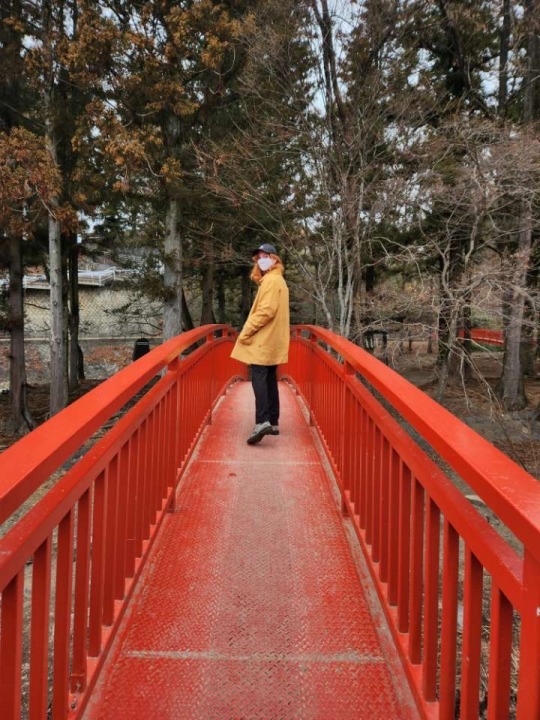

There was construction happening along the waterway, which detracted a bit from the 'natural' beauty of the shine, but nonetheless, the shrine was very cool and it was funky to be surrounded by water on all sides. It gave the shrine a very 'disconnected from the physical world' vibe.
Next to the sandbar was a long walkway, which lead us right to the sight of the Manji Buddha statue. I was really looking forward to seeing this statue, as it was featured in nearly every aspect of the town. In paintings, in warnings, in advertisements, the Buddha was there to greet you. The story of the statue is that, in the Edo period, a sculptor was beginning to carve the stone, when it suddenly began bleeding and the people panicked. Convinced it was sacred, the stone was then carefully carved into the likeness of Amitabha Buddha, with a somewhat humorous appearance of a tiny head with a large nose upon a bulbous body. By the statue were instructions on how to properly pray, which we gave an honest shot. The instructions read; Bow once and say your prayer in your heart, then circle the statue 3 times while chanting the prayer in your heart, then bow once more.
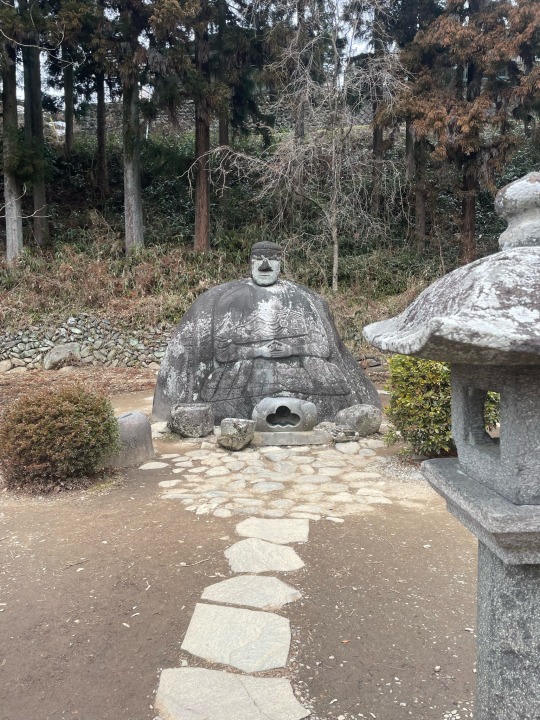
This was the end of our cultural walk, as it then began to rain and it was very cold out so we did not want to linger. On our way back to the Ryokan, we passed by the Gebabashi Bridge, which was the oldest standing wooden structure in Shimo-Suwa. It was shaped like a half moon, aka it was VERY steep. It was cool to see where the bridge once stood, as it was now in the smack middle of a main road.

On our last day in Shimo-Suwa, we finally made our way to the Suwako Watch & Clock museum, a museum that sports the oldest Hydrolyc clock tower in Japan. Shimo-Suwa is known as the birthplace of the modern clock in Japan, so it was only natural that they had a whole museum dedicated to clocks. It was fun to walk around the main museum and see many different forms of clocks dating way back in the day to modern watches, and there were several interactive exhibits that explained how clocks worked, which was informative and fun. The main call of the museum, however, was the world's first fully operational water-powered astronomical clock tower that was in the courtyard.
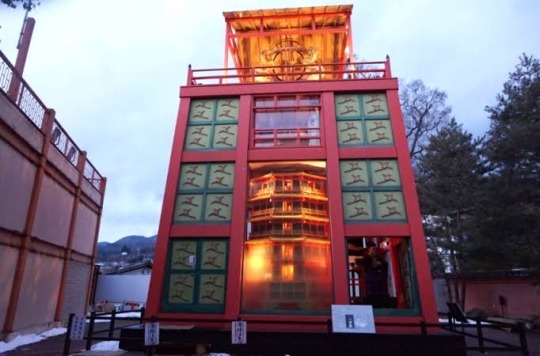
This clock is over 900 years old (WOAH), and had been refurbished with (kind of creepy) statues to represent the workers that used to remain within the clock tower. We were actually allowed inside the tower, where two staircases lead you from the ground floor (where all of the old tech was), to the second floor, where an astronomical globe was carved with 1314 stars that were known at the time. (..I think. I honestly cannot find the paper that told me the star count)
Each hour, when the clock would chime, the main tower in the center (seen above) would spin with little statues, and little men would strike on drums or on bells. On the right-hand side, two doors would swing open and reveal a wax figure animatronic (again, kind of creepy) that would narrate...something. I don't know Japanese practically at all, so I did not catch what the animatronic was saying, but it was funky.
Our time in Shimo-Suwa had come to an end, and I have this to say: Nowhere in the US can you walk around a tiny town with this much history. Literally, since half of the shrines were made before the US was founded. Isn't that insane??
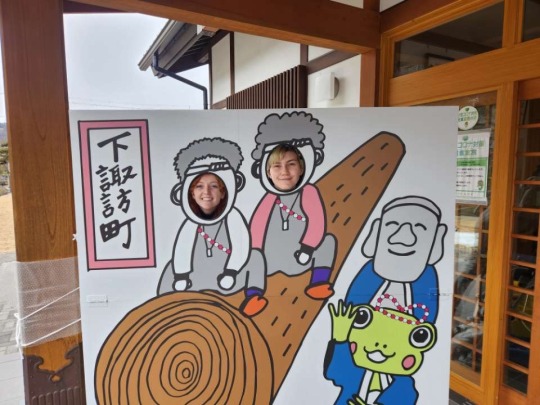
#shimosuwa#japan photos#studyabroad#nagano#hotsprings#japanese culture#japanese history#buddha#shrine
0 notes
Text
Kamisuwa Onsen, collected random infos
Back in March, a reader of this blog asked for a blog entry in the vein of previous "the look of..." features, but for Kamisuwa Onsen 上諏訪温泉.
Sadly, there isn't much visual material available and the basic look of the 3 or less remaining Geisha boils down to: Yohatsu, Homongi, light-coloured Obiage, Otaiko Musubi, or the formal look: Tsubushi Shimada, Kurotomesode, red Obiage, Otaiko Musubi. So here, I present some collected random infos you might find interesting.

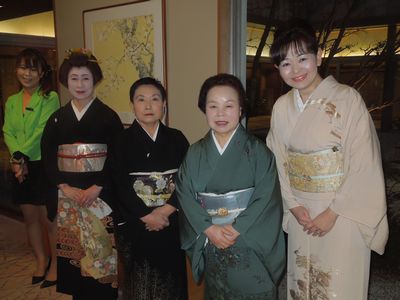
Kamisuwa Geisha, Setsubun 2014
Dances
Kappore かっぽれ
Takeda bushi 武田節
Kiso bushi 木曽節
Kohan bushi 湖畔節
Ina bushi 伊奈節
Shôchikubai 松竹梅 (performed in the new year season)
Tsurukame 鶴亀 (performed at wedding receptions and birthdays)
O-Suwa Takashi お諏訪節
Sukêto bushi スケート節 (Ice skating on lake Suwa)
Kirigamine kouta 霧ヶ峰小唄 (ice skating)
Onhashira kouta 御柱小唄
Suwa ondo 諏訪音頭 (about the beauty of Suwa throughout the seasons)
Okaya kouta 岡谷小唄 (about the Okaya silk industry)
Numbers
1930's ("early Showa period"): 200 Geisha in Kamisuwa
1958: 80
1960's: 300
2006: 3
History
The first Hanamachi on lake Suwa developed in Nawatemachi 縄手町/畷町 in 1903 (renamed to Otemachi 大手町 in 1909). In the following years, a few Ryotei were established. In 1920, the area of Otemachi 1 and 2 chôme was designated as area for Geisha, so Okiya and Ryotei of the neighbouring Izumichô area 和泉町 were moved there. In the early Showa period (1920's/30's), Okiya that were formerly located in Hamamachi also moved to Otemachi.
Kamisuwa had two kenban: Ote kenban 大手見番 and Koyanagi kenban 湖柳見番.
In Shimosuwa 下諏訪, it seems kenban had no specific names.
In Okaya 岡谷, there used to be another Koyanagi kenban 小柳見番 in the Honmachi area.
In Chino 茅野, there were Miyagawa kenban 宮川見番 (current Miyagawacho area), and Eimei kenban 永明見番 (current Nakacho area).
Before the around 1969/70, Geisha of these respective cities did not work in other cities. But with the decline of Geisha numbers, the Hanamachi in Okaya, Shimosuwa and Chino were no longer able to meet the demands of their customers, so it was allowed for Geisha from Kamisuwa to pad those numbers.

Chiyomaru 千代丸 in "Showa Meigiren", 1988
Daily life
Geisha usually practiced their respective arts (such as Narimono, Nagauta, Kouta, dance) until 15:00, afterwards they went to the beauty parlour to get their hair done, put on makeup and change into work clothes. Ozashiki usually lasted for two hours.
Style
In the year 1935, Geisha still wore their natural hair instead of wigs, and their hairstyle changed, depending on rank and age. Hangyoku wore Momoware 桃割れ and Oshidori おしどり. Geisha under 26 years wore Yuiwata 結い綿 or Taka shimada 高島田, no info on Geisha between 26 and 30, Geisha aged 31 and above wore Geiko yui 芸こ結い, tsubushi (shimada?) つぶし, icho gaeshi 銀杏返, and yokai maki 夜会まき.
Around 1955, most Geisha wore short hair or western updos on a daily base and used Nihongami wigs for work.
Becoming Geiko
Three mediators who acted as go-between of Okiya and families/volunteers worked in Kamisuwa. According to Manchiyo, who worked from 1930 to 44 in Otemachi, the daughters of poor farmers and travelling entertainers were sold to the Okiya for 15 yen. When the parents met with the Okiya, the length of the girl's service was decided.
After becoming employed by the Okiya, the girls were doing "odd jobs", while taking lessons in Hanayagi-ryu dance, Shamisen and other arts. It's like Shikomi in Kyoto, although no specific term is named.
When a Hangyoku was ready to become a Geisha, she had to prove her skills in dance or shamisen to a council of dance/shamisen teacher, Okiya owner, senior Geisha, head of the Geisha association and a member of the Kenban. The Okiya spent around 30 yen for an Erikae, while the Geisha had to take a loan of 150-200 yen. If her parents were to borrow money during her time before becoming independent, it was added to her loan. If parents continued to ask for money and the Geisha's debt became too large, they often became prostitutes in order to pay off their debts.
Around 2 years after becoming Geisha, they became "Goshugi tori" ご祝儀取り - they receive some of the money from the Gyokudai, but tips were entirely for them to keep. The next level was called "share" 分け, when 40% of all earnings were her own. When becoming independent from their Okiya, they paid fees for food and being registered at the place. Most Geisha also had a patron after becoming independent, which also lead to most of them retiring before the age of 30.
@gardengeisha yes, this is about Kamisuwa Onsen located in Suwa-gun in Nagano prefecture!
Sources:
https://www.saginoyu.com/blog/10090 (2014)
地方花柳界における〈芸〉と〈色〉諏訪湖沿岸 地域の事例 (2015)
花街文化伝える学校が開校/長野・上諏訪温泉 (2008)
はなあかり: 昭和名妓連 (1988)
42 notes
·
View notes
Photo

🥫CB缶 Mudana-Cover缶🥫 CB缶用のカバーです! 題して「Mudana-Cover!!」 です‼️ CB缶のカバーにナスカンスナップ!ナスカン付けないでしょ! ・ CB缶のカバーにグリップ(取手)要らないでしょ! ・ っと思うのですが、ただのカバーでは面白くなく、、、。 ・ 無駄な機能が必要な方、どうぞ‼️ ・ @noraworks_com #CBcan#cbbombe#cb缶カバー #CB缶ホルダー#CB缶#3色展開#leathercraft #leathertools #handmade #handcraft #ordermade #original #vintage #shimosuwa #nagano #japan #madeinjapan #革細工 #革工具 #革 #ハンドメイド #ハンドクラフト #手作り #noraworks #noraleathertools #レザー #レザークラフト #ハンドメイド #ハンドクラフト #leather (長野県下諏訪町) https://www.instagram.com/p/CJqXQyvhY7i/?igshid=2lbfle46g0bh
#cbcan#cbbombe#cb缶カバー#cb缶ホルダー#cb缶#3色展開#leathercraft#leathertools#handmade#handcraft#ordermade#original#vintage#shimosuwa#nagano#japan#madeinjapan#革細工#革工具#革#ハンドメイド#ハンドクラフト#手作り#noraworks#noraleathertools#レザー#レザークラフト#leather
2 notes
·
View notes
Photo

⛳1755. 慈雲寺庭園 ② Jiunji Temple Garden, Shimosuwa, Nagano ーータイプの異なる3つの名園。武田信玄作庭説もある池泉庭園に京都 #植音 が手掛けた石庭、#小口基實 作庭の枯山水庭園。 ・・・・・・・・ 石庭“帰錫庭”の他にも美しい庭園が続きます! . ■池泉庭園 最初の作庭は鎌倉時代に #一山一寧禅師 とも、室町期に #武田信玄 とも伝わる古庭園で、現在の姿に整えられたのは江戸時代後期の1837年(天保8年)。 大きな亀島🐢の浮かぶ #池泉鑑賞式庭園 で、その歴史から言っても文化財指定を受けていないのが意外。 池のほとりにある茶室も気になります。 . ■書院庭園 で、最後に書院前にも苔の美しい #枯山水庭園 があります。 こちらはお寺のリーフレットには情報がないけど #小口基實 さんの実績一覧に記載あり。それによると2004年に作庭(改修)されたもの。なお小口造園は2000年代に書院庭園の他にも参道や境内の整備なども担当されたそう。 横たわった苔むした巨石も、石橋から蓬莱山を眺める景色の移ろいも素晴らしい!3つの庭園の中で規模は一番小さいけど、これだけでも見る価値あるぐらい…。 . という感じで見所がとても多いお寺です。諏訪エリアは温泉や諏訪大社⛩だけじゃなく、素晴らしい庭園が沢山あるな〜。 . またあわせて上諏訪と下諏訪の途中にある『柿蔭山房(島木赤彦住居)』も更新しました。アララギ派歌人 #島木赤彦 の旧宅。こちらにも江戸時代末期の邸宅と樹齢300年ともいう巨大なアカマツ🌴が残ります。あわせてどうぞ! 〜〜〜〜〜〜〜〜 🔗おにわさん記事URL: https://oniwa.garden/jiunji-temple-%e6%85%88%e9%9b%b2%e5%af%ba%e5%ba%ad%e5%9c%92/ ーーーーーーーー #庭園 #日本庭園 #古庭園 #garden #japanesegarden #japanesegardens #zengarden #諏訪 #下諏訪 #下諏訪町 #suwa #shimosuwa #信州 #長野 #長野県 #nagano #枯山水 #karesansui #小口造園 #おにわさん #oniwasan (慈雲禪寺) https://www.instagram.com/p/B_M6QE8hxTM/?igshid=1egvx7a2zqfq1
#植音#小口基實#一山一寧禅師#武田信玄#池泉鑑賞式庭園#枯山水庭園#島木赤彦#庭園#日本庭園#古庭園#garden#japanesegarden#japanesegardens#zengarden#諏訪#下諏訪#下諏訪町#suwa#shimosuwa#信州#長野#長野県#nagano#枯山水#karesansui#小口造園#おにわさん#oniwasan
1 note
·
View note
Photo

諏訪大社下社秋宮にほど近い #オルゴール記念館 #すわのね 日本電産の株主優待を駆使し 無料で入館 冷蔵庫並の大きさの 昔のオルゴールなどが展示されてた 実際の演奏も聞けて良かった 訪問日:2020(令和2)年8月9日 #長野県 #下諏訪町 #下諏訪 #shimosuwa #co4noゆるキャンΔ聖地巡礼記録 (日本電産サンキョーオルゴール記念館 すわのね) https://www.instagram.com/p/CEIjwvRFLyq/?igshid=o54dmienug9e
0 notes
Photo



Shimo-Suwa
#photography#photograph#photo#Japanese photography#japanese photo#japan#japanese#japan travel#japantrip#japan trip#japantravel#travelling#shimosuwa#ducks#elderly woman#water#mountain#blue
2 notes
·
View notes
Photo

Shimosuwa, from the series Sixty-Nine Stations of the Kisokaidō, Utagawa Hiroshige, 1835-38, Cleveland Museum of Art: Japanese Art
The foreground of this print shows travelers enjoying an evening meal at an inn, with the proprietor looking pleased at the gusto of her guests. In the background, another traveler is gratefully relaxing in a large wooden tub filled with hot natural spring water, having discarded his robe next to the bath. Shimosuwa is the only stop along the Kisokaidō—a road running from Nibonbashi in Edo (now Tokyo) to Sanjō Ōhashi in Kyoto—with a natural hot spring. The print series was a collaboration between Hiroshige and Keisai Eisen (1791–1848).
Size: Sheet: 23.1 x 25.4 cm (9 1/8 x 10 in.)
Medium: Color woodblock print
https://clevelandart.org/art/1985.322
34 notes
·
View notes
Text
Zanza, impudent lone wolf and fight merchant; does his research before a fight by going to Kyoto to get info on the Battousai. (Ch6)

...so how did he get himself so lost going back to Kyoto?! (Ch72)

(My HC is that he knows how to get there, but left for Kyoto too pissed off to even think straight and by the time he realized he was lost, it was too late. Once he realized he was in Shimosuwa, it was smooth sailing to Kyoto. But still, lol precious dumbass)
#ruroken#rurouni kenshin#sanosuke sagara#hiten mitsurugi caused brain damage#Ryutsuisen to the head made Sano dumb#Zanza#fighter for hire#fight merchant
20 notes
·
View notes
Photo




八島ヶ原湿原 Yashimagahara-shitsugen
長野県諏訪郡下諏訪町 Shimosuwa-machi, Suwa-gun, Nagano, Japan
2009/09
30 notes
·
View notes
Photo

親の愛は、深いですね😙 ・ ・ 10万円相当のiPhoneを1年経たないうちに跡形も無く失くしてしまう、長男からsuica入れを頼まれました。 ・ ・ 当然、住所と名前を入れておきました‼️ ほんとうは、「YOKU OTOSHIMASU HIROTTARA TODOKETEKUDASAI」って刻印を打とうと思いました。が、使ってもらえないと困るので流石にやめました。 ・ ・ 親の愛を感じます。 ・ ・ @noraworks_com #suicaパスケース #leathercraft #leather #leathertools #handmade #handcraft #leathergear #ordermade #original #diy #craft #vintage #shimosuwa #suwa #nagano #japan #madeinjapan #革細工 #革工具 #革 #ハンドメイド #ハンドクラフト #手作り #noraworks (Shimosuwa-machi Suwa-gun, Nagano, Japan) https://www.instagram.com/p/B6a8kPnBwti/?igshid=wnh1cmx9e48p
#suicaパスケース#leathercraft#leather#leathertools#handmade#handcraft#leathergear#ordermade#original#diy#craft#vintage#shimosuwa#suwa#nagano#japan#madeinjapan#革細工#革工具#革#ハンドメイド#ハンドクラフト#手作り#noraworks
0 notes
Photo

\おにわさん更新情報📸/ [ 長野県下諏訪町 ] 聴泉閣かめや庭園 Chosenkaku Kameya's Garden, Shimosuwa, Nagano の写真・記事を更新しました。 ーー中山道・下諏訪宿の本陣だった温泉宿に残る、#小堀遠州 作庭と伝わる桃山〜江戸時代の池泉鑑賞式庭園。 ・・・・・・・・ こんな時だから、地元のホテルや旅館はどう?シリーズ。 「聴泉閣かめや」は長野・下諏訪にある温泉旅館♨️ 江戸時代には隣接する『本陣岩波家』とともに #中山道 #下諏訪宿 の本陣だった施設であり、#江戸幕府 #徳川将軍家 の歴代の御台所(正室)が宿泊したという「上段の間」に小堀遠州作と伝わる庭園が残されています。 幕末には #新選組 の近藤勇らも宿泊したという下諏訪宿の本陣。「かめや」としての営業が始まったのは明治時代以降で、近代には島崎藤村、芥川龍之介、与謝野晶子、与謝野鉄幹、宇野浩二、西條八十といった #文豪 🖋が滞在したことも。 2017年には下諏訪に足を運んだ際、ちょうど「十四代将軍・徳川家茂公の正室となった皇女 #和宮 さま宿泊150周年につき、展示室と庭園の見学」という看板が出ていて、初めて見学。そして2019年7月に再訪しました!(現在も見学可能かどうかは事前に問合せを) その「上段の間」に残された #池泉鑑賞式庭園は桃山時代〜江戸時代初期に造られたもので、作庭は小堀遠州とされています――が史料が残されているか(小堀遠州がこの時期下諏訪へ訪れているか)は不明。 ただ確かに、その心字池とその築山の滝石組は遠州の本拠地である近江国・長浜辺りで見る江戸時代の庭園を近いところを感じます。 この庭園、お隣の岩波家とも元々繋がっていたのかな?という感じの門があることに今回気づいた。併せて立派な庭園だったのかもしれないなあ。 宿泊の方は夜に庭園を眺めることも。温泉宿を探す時の決め手にもどうぞ! 〜〜〜〜〜〜〜〜 🔗おにわさん記事URL: https://oniwa.garden/chosenkaku-kameya-garden-%e8%81%b4%e6%b3%89%e9%96%a3%e3%81%8b%e3%82%81%e3%82%84%e5%ba%ad%e5%9c%92/ ーーーーーーーー #庭園 #日本庭園 #garden #japanesegarden #japanesegardens #諏訪 #下諏訪 #下諏訪町 #suwa #shimosuwa #信州 #長野 #長野県 #nagano #長野ホテル #長野旅館 #ryokan #koborienshu #enshukobori #皇女和宮 #おにわさん (聴泉閣かめや) https://www.instagram.com/p/B-T831RAZS9/?igshid=1sdypnh29ujxr
#小堀遠州#中山道#下諏訪宿#江戸幕府#徳川将軍家#新選組#文豪#和宮#池泉鑑賞式庭園は桃山時代#庭園#日本庭園#garden#japanesegarden#japanesegardens#諏訪#下諏訪#下諏訪町#suwa#shimosuwa#信州#長野#長野県#nagano#長野ホテル#長野旅館#ryokan#koborienshu#enshukobori#皇女和宮#おにわさん
0 notes
Photo

4つある #諏訪大社 のうちのひとつ #諏訪大社下社秋宮 訪問日:2020(令和2)年8月9日 #下社秋宮 #長野県 #下諏訪町 #下諏訪 #shimosuwa #御朱印 #ご朱印 #goshuin #co4noゆるキャンΔ聖地巡礼記録 https://www.instagram.com/p/CEF7eknFfj9/?igshid=1kspfq6lto3l3
0 notes
Photo


2013.8.29 JR中央本線 下諏訪駅
ShimoSuwa Station
47 notes
·
View notes
Photo

Shimosuwa: Yaegaki-hime, from the series Sixty-nine Stations of the Kisokaidô Road by Utagawa Kuniyoshi (1852)
#utagawa kuniyoshi#art#ukiyo-e#woodblock prints#fine art#19th century art#19th century#vintage art#vintage#woodblock print#japanese artist#japanese art#japanese#japan#japanese folklore#princess#fox spirit#fox#foxes#edo period
195 notes
·
View notes


